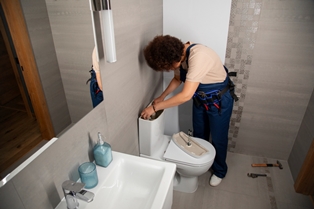Welcome to our comprehensive guide on unclogging a toilet without a plunger, particularly when the water level is alarmingly high. A clogged toilet can be a source of frustration and stress, but fear not, as we’re here to provide you with effective solutions to tackle this common household dilemma. Whether you’re facing a minor blockage or a more severe issue, we’ve got you covered with practical tips and techniques that can help you resolve the problem quickly and efficiently.
Assessing the Situation
Before diving into unclogging methods, it’s essential to assess the severity of the clog and determine the cause. Inspect the toilet bowl carefully to identify any visible obstructions such as toilet paper, hygiene products, or foreign objects that may be causing the blockage. Additionally, consider whether the clog is due to a buildup of waste or if there are underlying issues with the plumbing system that require professional attention.
Safety Precautions
Safety should always be a top priority when dealing with a clogged toilet, especially when the water level is high. To prevent potential water damage and ensure your well-being, follow these safety precautions:
Wear protective gloves:
Shield your hands from bacteria and germs by wearing rubber or latex gloves before handling any toilet-related tasks.
Use eye protection:
In case of splashing or spraying water, wearing safety goggles can safeguard your eyes from harmful bacteria and contaminants.
Ventilate the area:
If possible, open windows or use a fan to improve air circulation and reduce the risk of inhaling unpleasant odors or harmful fumes.
Effective Unclogging Methods
Hot Water and Dish Soap
One of the simplest yet most effective methods for unclogging a toilet without a plunger involves using a combination of hot water and dish soap. Here’s how to do it:
- Add dish soap:
Squeeze a generous amount of dish soap into the toilet bowl. Allow the soap to sit for a few minutes, as it helps lubricate the clog and break down any organic matter.
- Flush:
After letting the hot water and dish soap mixture work its magic for about 10-15 minutes, attempt to flush the toilet. If the water level starts to recede, continue flushing until the clog is fully cleared.
Plumbing Snake or Wire Hanger
For more stubborn clogs that cannot be easily dislodged with hot water and soap, a plumbing snake or wire hanger can come in handy. Follow these steps:
- Insert the snake or hanger:
Carefully insert the end of the plumbing snake or straightened wire hanger into the toilet drain, pushing it gently until you feel resistance.
- Rotate and maneuver:
Once the snake or hanger is inserted, rotate it clockwise and maneuver it back and forth to break up the clog and clear the obstruction.
- Flush and repeat:
After dislodging the blockage, flush the toilet to see if the water drains properly. If necessary, repeat the process until the clog is completely removed.
Baking Soda and Vinegar
The chemical reaction between baking soda and vinegar can create a powerful fizzing action that helps dissolve stubborn clogs. Here’s how to use this natural remedy:
- Pour baking soda:
Start by pouring one cup of baking soda into the toilet bowl, making sure to distribute it evenly around the inside of the bowl.
- Add vinegar:
Next, pour one cup of vinegar into the toilet bowl, allowing it to mix with the baking soda. As the two ingredients react, they will produce a bubbling effect that can help dislodge the clog.
- Let it sit:
Allow the baking soda and vinegar mixture to sit in the toilet bowl for at least 30 minutes, allowing it to penetrate and break down the clog.
- Flush with hot water:
After the allotted time has passed, flush the toilet with hot water to wash away the dissolved debris and unclog the drain.
Preventive Measures
To avoid future toilet clogs and maintain optimal plumbing performance, consider implementing the following preventive measures:
- Use less toilet paper:
Reduce the amount of toilet paper used with each flush to minimize the risk of clogs.
- Regular maintenance:
Schedule routine plumbing inspections and maintenance checks to identify and address any potential issues before they escalate into major problems.
FAQs
Here are the answers to frequently asked questions about unclogging a toilet without a plunger:
Yes, you can use any type of dish soap for unclogging a toilet. The key is to use a generous amount to help lubricate the clog and break down organic matter effectively.
It’s recommended to wait for about 10-15 minutes after pouring hot water into the toilet bowl before attempting to flush. This allows the hot water to soften the clog and improve the effectiveness of the flushing process.
While using a wire hanger can be effective for dislodging stubborn clogs, there is a risk of damaging the porcelain surface of the toilet bowl if not used carefully. To minimize this risk, avoid using excessive force and gently maneuver the hanger or consider using a plastic plumbing snake as an alternative.
Yes, you can use commercial drain cleaners as an alternative to natural methods such as baking soda and vinegar. However, be cautious when using chemical-based cleaners as they may contain harsh ingredients that can damage pipes or harm the environment. Always follow the manufacturer’s instructions and use protective gear when handling commercial drain cleaners.
If none of the aforementioned methods work to unclog the toilet, it may be time to seek professional assistance from a plumber. Persistent clogs may indicate underlying issues with the plumbing system that require professional diagnosis and repair. Avoid using excessive force or harsh chemicals, as these can exacerbate the problem and potentially cause further damage.
Conclusion
Unclogging a toilet without a plunger when the water is high can be accomplished using simple yet effective methods such as hot water and dish soap, a plumbing snake or wire hanger, or a baking soda and vinegar mixture. Prioritize safety, assess the severity of the clog, and implement preventive measures to minimize future issues. By following these steps, you can confidently tackle toilet clogs and maintain optimal plumbing performance.













Find Us on Socials